The best single metric for B2B sales success is sales velocity. As a measure of performance, sales velocity provides a clear way to organize the essential factors that will drive immediate revenue growth. It measures how quickly deals move through the pipeline. The formula for sales velocity is simple:
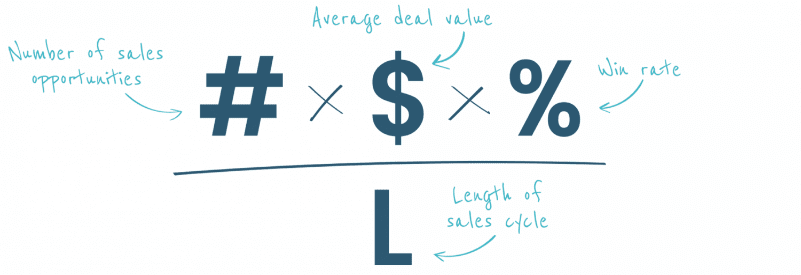
Value selling increases sales velocity by centering customer conversations on the outcomes our solution will deliver to them. Good value selling is neither death by spreadsheet nor is it marketing mush. It is a qualitative, quantitative, and financial conversation centered on the customer’s problems, adapted to customer specifics, that creates a compelling vision of what our solution will deliver to them. That vision includes the dollarized or euro-ized results they can expect.
There are four levers in the sales velocity formula, each one of which increases sales speed:
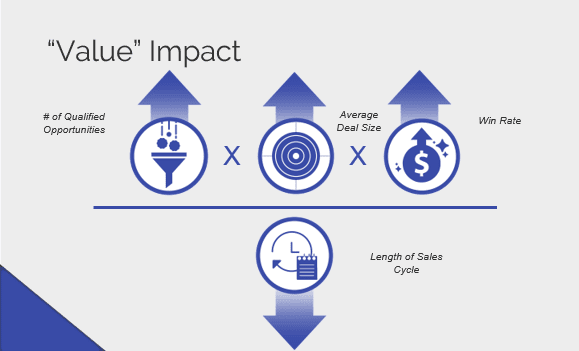
- Increase the Number of Qualified Opportunities
- Increase the Average Deal Value
- Increase the Win Rate
- Reduce the Length of Sales Cycles
 At LeveragePoint, we are fortunate to collaborate with world class companies as they implement value selling using our online platform. Based on these partnerships, we have compiled best practices, interviews, and data about value selling that shed light on its impact on sales velocity.
At LeveragePoint, we are fortunate to collaborate with world class companies as they implement value selling using our online platform. Based on these partnerships, we have compiled best practices, interviews, and data about value selling that shed light on its impact on sales velocity.
The Impact of Value Selling on Sales Velocity. Let’s summarize the data supporting value selling.
 Value Selling Increases Qualified Opportunities. A customer-centered conversation about value delivered helps sales reps connect with prospects, navigate customer organizations early, and qualify opportunities faster. Value selling often simultaneously increases the number of potential opportunities for a sales rep to pursue, while focusing the rep’s time on fewer, more qualified opportunities. Measuring sales opportunities is straightforward, but tracking qualified opportunities is more challenging. Relating the use of Value Propositions tracked in a CRM with qualified opportunities is only as good as the data that sales reps report. Qualifying deals out of the pipeline fast is a skill that middle performers often need to improve and where value selling can help. As a result, a before and after CRM-based analysis tends to be noisy.
Value Selling Increases Qualified Opportunities. A customer-centered conversation about value delivered helps sales reps connect with prospects, navigate customer organizations early, and qualify opportunities faster. Value selling often simultaneously increases the number of potential opportunities for a sales rep to pursue, while focusing the rep’s time on fewer, more qualified opportunities. Measuring sales opportunities is straightforward, but tracking qualified opportunities is more challenging. Relating the use of Value Propositions tracked in a CRM with qualified opportunities is only as good as the data that sales reps report. Qualifying deals out of the pipeline fast is a skill that middle performers often need to improve and where value selling can help. As a result, a before and after CRM-based analysis tends to be noisy.
In interviews, sales leaders report an observable effect on qualified opportunities when sales reps start using a value selling approach. Naturally, this is based on the leader’s judgment of which opportunities are qualified. Based on conversations with sales leaders, we estimate that sales performers, who use Value Proposition materials as part of their selling process, experience an increase in qualified opportunities by up to 20% over their prior year levels.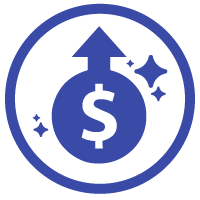 Value Selling Increases Average Deal Value. Value Selling enables sales teams to differentiate their offering, providing the context and confidence for a defensible price premium. It increases average deal value, whether measured as deal size, average prices, or average margins. A number of LeveragePoint customers track one or more of these measures, comparing them to the use of a Value Proposition in sales opportunities in their CRMs. Across an array of value selling organizations in different industries, opportunities using a Value Proposition result in higher prices on average that range from 5% to 25%.
Value Selling Increases Average Deal Value. Value Selling enables sales teams to differentiate their offering, providing the context and confidence for a defensible price premium. It increases average deal value, whether measured as deal size, average prices, or average margins. A number of LeveragePoint customers track one or more of these measures, comparing them to the use of a Value Proposition in sales opportunities in their CRMs. Across an array of value selling organizations in different industries, opportunities using a Value Proposition result in higher prices on average that range from 5% to 25%.
Rick Cantril, Director of Value-Based Strategies at Fiserv, a LeveragePoint customer, reports 15% greater profitability on average when a Value Proposition is used in an opportunity. Cantril indicates that, “the relationships we build are far stronger—resulting in an average of more than three times more investment from our clients in partnerships where LeveragePoint helped build the business case.” A business unit leader at another LeveragePoint customer, summarizes their results. “Overall we estimate a 2-4% increase in gross margin on all new projects/offers dealt with.” Other value selling organizations report discount reductions of up to 12%. Value Selling Increases Win Rates. By focusing sales conversations on customer problems and outcomes, value selling makes sales teams more effective in closing deals. By tracking the use of a Value Proposition by sales opportunity in their CRM, a number of LeveragePoint customers have been able to estimate the impact of value selling on their close rates. Across value selling organizations in different industries, opportunities using a Value Proposition result in higher close rates on average from 5% to 15%.
Value Selling Increases Win Rates. By focusing sales conversations on customer problems and outcomes, value selling makes sales teams more effective in closing deals. By tracking the use of a Value Proposition by sales opportunity in their CRM, a number of LeveragePoint customers have been able to estimate the impact of value selling on their close rates. Across value selling organizations in different industries, opportunities using a Value Proposition result in higher close rates on average from 5% to 15%.
Rick Cantril at Fiserv tracks Net Promoter Scores among sales users of Value Propositions as well as close rates by opportunity. “Our internal sales and solutions experts have consistently given LeveragePoint high praise with a net promoter score of over 90% positive, and this energy has helped us increase our average win rate by 10% across hundreds of solutions and thousands of opportunities.” Other value selling organizations, many of them in software, report a range of improvement in close rates from 20% to 75%. Value Selling Shortens Sales Cycles. Sales teams, facing multiple stakeholders and complex procurement processes, need a way to build consensus faster at buying organizations. Value conversations help align buyer teams around their own outcome and business goals in buying a solution. Value discussions, by their nature, are expressed in a business language that allows sales teams to rise above technical, feature-based presentations.
Value Selling Shortens Sales Cycles. Sales teams, facing multiple stakeholders and complex procurement processes, need a way to build consensus faster at buying organizations. Value conversations help align buyer teams around their own outcome and business goals in buying a solution. Value discussions, by their nature, are expressed in a business language that allows sales teams to rise above technical, feature-based presentations.
Sales leaders report that reps who start value selling show meaningful reductions in their sales cycles, with an estimated range of reduction in the average time to close deals of 5% to 20%. Rick Cantril at Fiserv tracks sales cycle time for opportunities once a Value Proposition is introduced in comparison to other comparable opportunities. “We saw sales cycle time reduced by 50-75% as our clients could make decisions faster when they had all of the data than when they had to make their own business cases.”
Measuring the Overall Impact. A number of value selling organizations have seen significant impacts on each of the four levers in the sales velocity formula. These improvements need not be dramatic individually, given their combined effects. Improving each lever by a few percentage points produces a cumulative effect, driving substantially increased revenue. Value Selling is a proven way to impact all four levers at once.
Let’s look at the combined impacts with two illustrative examples.
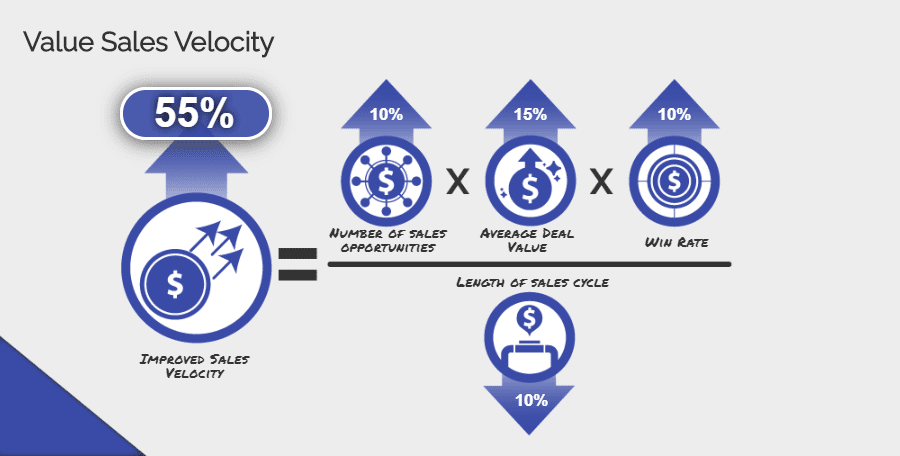 Suppose that each of the four levers in sales velocity are improved well within the range of estimates provided above:
Suppose that each of the four levers in sales velocity are improved well within the range of estimates provided above:
- 10% rise in qualified opportunities
- 15% increase in deal value
- 10% increase in close rates
- 10% reduction in sales cycles
The overall increase in sales velocity based on these levels of performance improvement is 55%. If 40% of sales reps adopt value selling in an initial year, that drives first year revenue growth of 22%.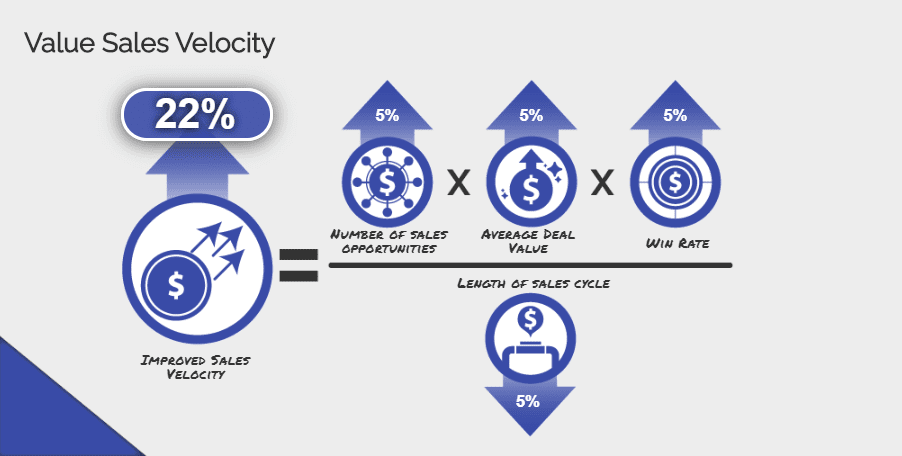 More conservatively, even if each of the four levers improve by only five percent, (at or below the low end of each of the estimates provided above), the increase in velocity is considerable.
More conservatively, even if each of the four levers improve by only five percent, (at or below the low end of each of the estimates provided above), the increase in velocity is considerable.
- 5% rise in qualified opportunities
- 5% increase in deal value
- 5% increase in close rates
- 5% reduction in sales cycles
The overall increase in sales velocity based on these conservative estimates is 22%. If 20% of sales reps adopt value selling initially, revenue growth of 4.5% is the result. The impact of a value selling implementation is meaningful.
Implementing value selling successfully requires a few critical initiatives – providing strong Value Proposition content and mobilizing sales are key among them. But the tangible and intangible benefits of driving value selling are worth the investment.

